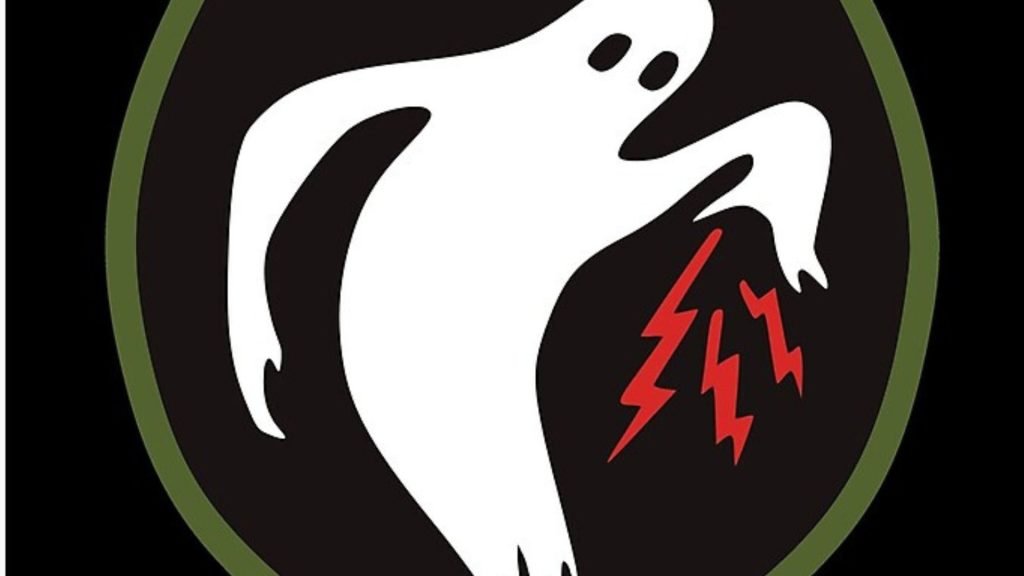My premise is audacious and may be met with skepticism, ridicule, or disbelief. But here it is: Donald Trump didn’t become a presidential candidate on a whim, or even by his own ambitions alone. I assert that Trump was handpicked by individuals within the Joint Chiefs of Staff of the U.S. Military. Their goal? To use him as the face of an intricate operation to root out corruption within the D.C. establishment and beyond.
This operation had several critical components. Firstly, the Military aimed to safeguard every United States citizen. Secondly, they deployed an unprecedented global psychological campaign using Special Forces and cutting-edge Irregular Warfare (IW) tactics. This included cyber warfare, information warfare, electronic warfare, intelligence warfare, and even space warfare. All designed to expose and counteract the clandestine activities of what is known as the Deep State.
In addition, the operation sought to amass evidence against Deep State operatives for actions dating back to at least the 2018 midterm elections. Ultimately, the goal was to restore the United States to its Constitutional principles and bring those guilty of treason and sedition to justice, including their foreign collaborators.
Much of what I have put together is largely based on the monumental work of Jon Herold, otherwise known by his online alias, @patelpatriot, and his Devolution series.
Let’s begin by listening to Trump’s final speech prior to the 2016 election, which sets the roadmap to all that is about to unfold: https://youtu.be/G2qIXXafxCQ
In a striking and unprecedented moment during Donald Trump’s 2016 inauguration speech, something quite extraordinary unfolded. Military personnel took up positions behind him, a sight that had never before been witnessed at a presidential inauguration. I encourage you to watch this captivating moment at the 3:59 mark in the video: Trump’s Inauguration Speech.
But it wasn’t just the unusual formation of military staff that caught attention. If you listen closely to Trump’s words at that exact moment, there is a poignant synchronicity between the substance of his speech and the powerful imagery of the military lineup.
What makes this so significant? The presence of military personnel could be interpreted as a symbolic endorsement or a display of unity. Considering the premise I introduced earlier – that Trump was recruited by members of the Joint Chiefs of Staff – this moment takes on an even deeper meaning. It’s worth noting the bands around the officers’ hats. The light-blue and gold stripes represent the military intelligence community, while the dark or navy blue and gold striped hats represent JAG, otherwise known as Judge Advocate General’s Corps, which is the branch of military justice for the entire armed forces. These could very well be the branches of the U.S. military Trump would likely use to carry out the aforementioned mission to restore the Republic.
Is it a mere coincidence, or could it be a subtle, yet profound, message to the American people and the world?
Whispers of Destiny: A General Plants the Seed
Picture this: It’s a glittering Marine Corps charity gala on April 24, 2015. The room is abuzz with dignitaries, and the spirit of camaraderie and patriotism is in the air. Among the attendees is none other than Donald Trump, who, at this point, is a successful businessman and television personality, not yet a presidential candidate.
As the night unfolds, an unexpected conversation takes place. General Joseph Dunford, the then Chairman of the Joint Chiefs of Staff, approaches Trump. His words would later reverberate through history as Trump recalled this very conversation during an installation ceremony for General Mark Milley, Dunford’s successor on September 30, 2019.
General Dunford, with the poise and gravitas that only a high-ranking military officer can command, encouraged Trump to consider a bid for the presidency.
Why is this moment so pivotal?
In hindsight, this exchange can be seen as a fascinating glimpse into the genesis of Trump’s journey to the White House. It draws a connection between the military and Trump’s decision to run for office, lending weight to the theory that his candidacy was not just a personal ambition but possibly encouraged by elements within the U.S. Military.
(Video: https://youtu.be/PCGJVkCoyTM?t=2539)
Trump’s key remarks on General Dunford:
42:11 – “…he also provided critical leadership during the rebuilding of our military. And he helped me in another way…”
44:30 — Joe has been a huge advocate for creating the sixth branch of the U.S. military, the Space Force; 3 months later Space Force is established.
Less than 2 months after the charity gala on…
June 16, 2015
The ripple effect of that fateful night at the Marine Corps charity gala was swift. Merely two months after his stirring conversation with General Dunford, Donald Trump stood amidst the towering grandeur of Trump Tower in New York City. The atmosphere was electric, as a throng of journalists, supporters, and onlookers held their breath.
With a flamboyance and confidence that only Trump could muster, he took the stage and made a declaration that would send shockwaves around the world: he was running for President of the United States.
The proximity between his chat with General Dunford and this monumental announcement begs the question – was that exchange more than mere coincidence? Did the words of a distinguished military general sow the seeds that blossomed into Trump’s presidential campaign?
As we ponder the potential catalysts behind Trump’s foray into politics, this chronology paints an intriguing picture of the possible influences and motivations at play.
As the calendar pages turn, we find ourselves fast-forwarding to exactly one year later – June 16, 2016. The political landscape is heating up, and the air is thick with intrigue.
On this day, CrowdStrike, a cyber-security firm with a razor-sharp reputation, takes center stage. Hired by the Democratic National Committee (DNC), CrowdStrike drops a bombshell. They reveal that they have unearthed Russian malware lurking in the shadowy depths of the DNC’s computer server.
But here’s where it gets even more captivating.
This discovery comes exactly one year after Donald Trump announced his candidacy. At this juncture, the rumblings of a Russian narrative against Trump begin to take shape. Could this be a mere coincidence in timing, or is there a pattern emerging?
Is it possible that this revelation, precisely a year after Trump threw his hat into the presidential ring, marked the nascent stage of what would later explode into an all-consuming narrative of Russian involvement in the election?
As the pieces of the puzzle begin to align, the construction of this narrative seems less like happenstance and more like a calculated development. The ensuing chapters of this saga are fraught with allegations, investigations, and fervent political theater. Hold on tight, as we delve deeper into the labyrinthine twists and turns of this riveting tale.
Crowdstrike and the timely death of a DNC Staffer
The clock ticks forward to July 10, 2016. The summer heat envelops Washington D.C., but it’s not just the temperature that’s rising – tensions and mysteries in the political landscape are simmering too.
In the early hours, a chilling event unfolds. Seth Rich, a young and vibrant DNC staffer, is found tragically murdered on the streets of the nation’s capital. The shockwaves are palpable, and whispers begin to circulate.
Rumors start swirling in certain circles that Seth Rich was not just an ordinary staffer. Some believe he was the whistleblower who handed over a trove of sensitive information to WikiLeaks – a thumb drive loaded with emails from Hillary Clinton and the DNC.
But, here’s where the plot thickens.
A mere 12 days later…
July 22, 2016
Fast forward to July 22, 2016, a day that would send tremors through the political landscape.
Just days before the Democratic National Convention, a bombshell hits. WikiLeaks, the whistleblower organization infamous for publishing classified information, releases a staggering 22,000 DNC emails. The political world is in an uproar.
But there’s something else, something hidden within the details that demands attention.
The metadata within the computer files reveals something astonishing. On the evening of July 5, 2016, at precisely 6:45 p.m., a colossal 1,976 megabytes of data were downloaded from the DNC’s server. The download was lightning-fast, taking just 87 seconds. This means the transfer rate was a blistering 22.7 megabytes per second.
Now, this is where the narrative takes an unexpected twist.
Veteran Intelligence Professionals for Sanity (VIPS), a group of seasoned former military intelligence officers, weighed in. According to their expert analysis, this speed is “much faster than what is physically possible with a hack.”
This revelation raises a storm of questions. If it wasn’t a hack, then what was it? An inside job? And how does this connect to the tragic demise of Seth Rich just days before, who was rumored to have been in possession of a thumb drive containing these very emails?
The plot thickens as the pieces of this complex puzzle continue to move.
Source: Intel Vets Challenge ‘Russia Hack’ Evidence
Trump Wins 2016 Election & Illegal Surveillance is Revealed
November 8, 2016
Trump is declared the victor of the 2016 general election; he loses the popular vote but wins the electoral vote.
November 17, 2016
In the pulsating aftermath of the 2016 election, a shadowy cloak-and-dagger episode unfolds in New York City.
Just two weeks after the ballots have been cast, Admiral Mike Rogers, the esteemed NSA Director, makes a covert visit to Trump Tower. His mission? To alert President-elect Trump of a chilling discovery: illegal spying on U.S. citizens by the Obama administration.
Hold on a minute. How did Admiral Rogers stumble upon this?
After meticulously auditing the NSA’s surveillance records under Section 702 – a provision that typically deals with the surveillance of U.S. citizens – he unearthed this questionable activity.
The Obama administration’s reaction is seismic.
Infuriated by Admiral Rogers’ revelation, Obama’s National Security Advisor, Susan Rice, orchestrates a secretive meeting in the White House’s Situation Room. Remarkably, this gathering is conducted without audio – ensuring nothing is recorded.
You might expect Admiral Rogers to be invited to such a meeting. But no. Instead, an eclectic assembly of high-ranking officials congregates, including Secretary of State John Kerry, who notably lacks investigative powers.
Sitting around the table are John Brennan, James Comey, James Clapper, Ash Carter, Jeh Johnson, Jack Lew, Loretta Lynch, and – wait for it – General Joseph Dunford, Chairman of the Joint Chiefs of Staff. Dunford’s name is an echo from earlier in our narrative, when he urged Trump to run for the presidency.
Fast-forward to December 2019. The Intercept drops a bombshell: Admiral Mike Rogers has been secretly assisting John Durham’s investigative team for months.
Now, let’s pause for a second. Remember when Trump, with a glint in his eye, told the media, “I caught them, we have it all”? What could he possibly have meant?
As the pieces of this intricate web start to interlock, the scope and depth of what Rogers uncovered become all the more astonishing.
Dive into the following articles to grasp the full gravity of Admiral Rogers’ discovery and the illustrious cast of characters involved:
- Hero Admiral Rogers Secretly Met With Trump, Assisting John Durham
- Michael Rogers’ Role in Trump-Russia Investigation
- Conservative Treehouse Summary of Rogers’ Involvement
A Curious Sidebar: Tying the Threads of Election Infrastructure (January 6, 2017)
Before we forge ahead, let’s take a detour and flick on the high-beam for an intriguing morsel from January 6, 2017. This tidbit may appear unrelated at first, but keep your eyes peeled as it stealthily weaves into the tapestry of intelligence operations.
Now, the White House is abuzz as Jeh Johnson, Obama’s Secretary for Homeland Security, makes a game-changing announcement. Through his statement, the very fabric of the American election system undergoes a seismic shift. How? By designating the “election infrastructure” as a vital cog in the nation’s “critical infrastructure”.
What does this mean in layman’s terms? Essentially, an assault on the U.S. election system, whether by foreign marauders or homegrown troublemakers, would now be equated with an act of war. The gravity of this designation is echoed by General Nakasone, a tidbit to file away for later.
Now, let’s pull back the curtain on the private sector advisers that Obama’s administration enlisted for insights on safeguarding this critical election infrastructure. The list is, to say the least, eye-opening. Dominion, Smartmatic, and Scytl – do these names set off any alarm bells? Flash forward, and they’re the ones under the spotlight for their role in the 2020 election saga.
Let’s keep this breadcrumb in our back pocket as we venture forward. The threads are starting to intertwine, and this piece of the puzzle might just be the key to deciphering a larger picture.
Read the Official Statement by Secretary Johnson
——— Let’s take a look at what is also happening around this same time ———
January 17, 2017
Steele dossier to smear Trump is leaked to the media; dossier is leaked to media through a staffer in Senator John McCain’s office
A Parallel Saga Unfolds: Nunes Takes the Stage
Let’s swivel our spotlight to another corner of the stage, as the events of March 2017 unfurl. An intriguing subplot is taking shape, and it’s about to add another layer of complexity to this already convoluted narrative.
Enter Devin Nunes, a Republican congressman from California with a glint in his eye and a mission in his heart. As the chairman of the House Intelligence Committee, he’s not one to shy away from a challenge.
With a flourish, Nunes launches an investigation into none other than the mighty FBI and DOJ. His quarry? He’s on the trail to unravel whether top brass from these agencies deftly “unmasked” and then strategically leaked the names of Trump associates caught in the web of intelligence reports during the precarious transition period.
But Nunes isn’t working alone. The plot thickens as the New York Times unearths one of Nunes’ informants – Ezra Cohen-Watnick, who holds the reins as a senior director for intelligence at the National Security Council. Keep a tab on this name; Ezra is akin to a chess piece that will make a critical move in the endgame of the Trump administration.
And who’s wielding the pen behind the scenes? Much of the classified memo, which would later see the light of day in 2018, was crafted by Kash Patel. Serving as a top aide to Nunes and a senior committee counsel, Patel’s ink narrates the twists and turns of this intelligence saga.
As we delve deeper into this labyrinth, the tapestry of events becomes increasingly entangled. Every player, every move counts.
Read the Source Article in The Atlantic
Trump Takes on Global Corruption: A Tale of Princes, Politics, and a Crusade for Justice
March 14, 2017, marks the beginning of a compelling chapter in international politics.
The Setting: The White House.
The Cast: President Donald Trump and Saudi Prince Mohammed bin Salman.
The world watches as Trump meets with the Saudi Prince in the iconic halls of the White House. Little did the onlookers know that this meeting would set the stage for seismic changes in the global landscape.
Prince Mohammed bin Salman, fresh from his meeting with Trump, goes on the offensive against corruption. A new anti-corruption committee takes shape under his leadership. In a stunning move, Prince Alwaleed bin Talal, along with 10 other princes, is arrested. Rumors swirl – allegations of human trafficking and pedophile rings involving bin Talal become the talk of the town. The port of Saudi Arabia, once whispered to be a hub for such despicable acts, is under scrutiny.
The world has been waking up to the horrors of child sex trafficking and pedophilia among the elite. As if to amplify the message, a film, titled “Sound of Freedom,” is slated for release on July 4, 2023. Featuring Jim Caviezel, the movie portrays the heroic deeds of special agent Tim Ballard, who fought tooth and nail against the cartel to rescue innocent children from the claws of human trafficking.
Coincidence? Perhaps. Or a global reckoning taking shape.
As we explore the intricate web of events, it’s worth observing how President Trump was received by the Saudis in 2017. The warmth and camaraderie were palpable, hinting at shared goals and mutual support.
So, what does it all mean? As the world unravels, the forces against corruption and evil mobilize.
Read More About the Saudi Arrests
Watch Trump’s Reception in Saudi Arabia in 2017
Significance of the sword dance: it is performed in preparation for battle against one’s enemies; as a way to show off one’s own arsenal.
Juxtapose Trump’s reception in 2017 with Joe Biden’s reception by the Saudis in 2022:
April 2017
Trump meets with Chinese President Xi Jinping at Mar-a-Lago
(Source: At Mar-a-Lago, Trump welcomes China’s Xi in first summit – The Washington Post)
(Note: Later in November 7, 2017, Trump is invited by Xi to dine in the Xianfu Palace of the Forbidden City, something no U.S. president has done since the founding of the People’s Republic of China in 1949)
Why is this significant? Trump is treated like an ‘emperor.’ Even the MSM reports it as such.
The Plot Thickens: Trump’s Ominous Words Amidst Generals
Now, let’s step back into the main storyline and turn the pages to a particular scene that stands out. Remember Admiral Mike Rogers’ clandestine rendezvous with Trump in Trump Tower in NYC on November 17, 2016? The intrigue intensifies as we fast-forward to less than a year later.
The date is October 5, 2017. The White House press room is brimming with journalists, their pens at the ready and cameras trained on a figure at the podium. It’s President Trump. But he’s not alone. There’s a formidable backdrop – a cadre of military generals, possibly from the Combatant Commands (COCOM).
As the journalists lean in, Trump’s words waft through the room, sending ripples of confusion. “This is the calm before the storm,” he says cryptically. The press, known for their hawk-eyed scrutiny, are thrown into disarray. What storm, Mr. President? Calm before what? The questions fly, but answers remain shrouded in a veil of secrecy. President Trump delivers only a more ominous reply: “You’ll find out.”
You’ll notice who’s there with President Trump, but none other than General Joseph Dunford. And just a little further down, sharing the stage is you guessed it, the esteemed Admiral Mike Rogers.
This cryptic phrase, spoken amidst a phalanx of military might, is a puzzle piece that demands closer inspection. What did Trump mean by “the calm before the storm”? Theories abound, but the answers remain locked away. Considering these generals are part of Combatant Command (COCOM) you’ll soon learn – as you continue reading – the significance of their involvement in the quest to win back the Republic from the grip of a globalist cabal.
Watch the Video of Trump’s Press Conference
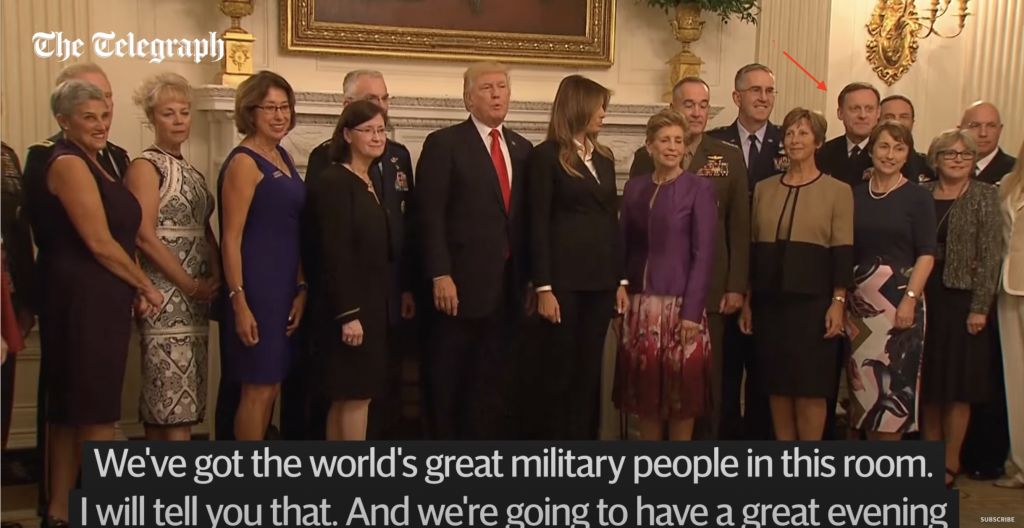
February 2, 2018: The Release of the Nunes Memo – A Clash of Narratives
On February 2, 2018, the political landscape in the United States is gripped by a contentious debate as the House Intelligence Committee approves the release of a memo authored by Republican congressman Devin Nunes.
The Nunes memo reveals that the Department of Justice (DOJ) and Federal Bureau of Investigation (FBI) sought and obtained a Foreign Intelligence Surveillance Act (FISA) order. This order authorized electronic surveillance on Carter Page, a volunteer advisor for the Trump presidential campaign.
Democrats react strongly to the release of the memo. Adam Schiff, the committee’s ranking Democrat, labels the decision as “transparently cynical and destructive,” voicing his opposition through social media.
However, the saga does not end there.
In response to the Nunes memo, Democrats in Congress hastily release their own counter-memo. This counter-memo aims to contradict the allegations made in the Nunes memo. However, it inadvertently confirms that the FBI utilized the Steele dossier as part of their rationale to acquire the FISA warrant. It is critical to note that the Steele dossier had been financed by the Clinton campaign and the Democratic National Committee (DNC).
The Steele dossier became a focal point of controversy due to its role in the investigation into potential collusion between the Trump campaign and Russia. Igor Danchenko, who contributed to the creation of the dossier, has been under scrutiny in the Durham investigation. Moreover, it has been revealed that Danchenko was on the FBI’s payroll for 3.5 years.
This clash of narratives between the Nunes memo and the Democrats’ counter-memo raises serious questions about the objectivity and impartiality of the institutions involved. The American public is left to discern truth in a sea of political maneuvering.
Sources:
- GOP Releases Nunes Memo by Kashyap Patel to Attack the DOJ, FBI for Donald Trump – Trumpfile
- Democrat Memo Confirms FBI Used Dossier, Never Told Court it Was Funded by Clinton Campaign and DNC – Mixed Times
July 16, 2018: Trump and Putin’s Landmark Meeting in Helsinki
On July 16, 2018, a highly anticipated and closely watched summit took place in Helsinki, Finland, between US President Donald Trump and Russian President Vladimir Putin. This summit was significant, as it came at a time when relations between the US and Russia were fraught with tension on various fronts, including accusations of Russian interference in the 2016 US Presidential election.
The leaders described the meeting in positive terms. President Putin labeled the dialogue as “candid and useful,” while President Trump spoke of a “deeply productive dialogue”. Trump made a noteworthy remark, stating that US-Russia relations had “never been worse” than they were before the Helsinki meeting, but expressed optimism that this had changed.
One of the distinguishing features of the Helsinki summit was a private meeting between the two leaders. They met behind closed doors for over two hours, accompanied only by their interpreters. This aspect of the meeting was closely scrutinized, as it was rare for the presidents of the US and Russia to meet without aides or note-takers.
The Helsinki meeting was one of five meetings between Trump and Putin during Trump’s presidency. It was especially significant due to its timing and the geopolitical tensions between the two countries. The private nature of the talks, as well as the leaders’ statements on improving relations, brought the summit to the center of global attention.
What did the two leaders discuss in such a private setting? How did this meeting impact the course of US-Russia relations? These questions were left largely unanswered, but the Helsinki summit nonetheless stands as a landmark event in the relations between the two world powers. Considering the intricacies of the war in Ukraine and Russian military revelations of DoD-funded biological research labs in Ukraine, this meeting between Trump and Putin could very well be the link to understanding Russia’s stance and why they haven’t gone full-on nuclear. But could pushing the world to the brink of nuclear war be the necessary piece that peals away the wool from the eyes of a spectating public who has drunk the globalist Kool-Aid for decades? And why would Trump claim he is the only one who could bring peace with Russia within 24 hours? What leverage does he have with Russia? I think we’ll eventually find out.
Source: BBC News – Trump-Putin summit: After Helsinki, the fallout at home
December 20, 2018: The Steele Dossier Leak and Its Aftermath
On December 20, 2018, a significant development took place that shed light on the origins of the Trump-Russia investigation, colloquially known as “Russiagate”.
It was revealed that a staffer associated with the late Senator John McCain had given the infamous Steele dossier to BuzzFeed News. The Steele dossier, which contained unverified allegations regarding Donald Trump’s ties to Russia, had been a contentious document since its emergence. The leak to BuzzFeed News played a pivotal role in igniting public interest in what would come to be known as the Trump/Russia collusion narrative.
Source: Fox News – McCain associate gave unverified Steele dossier to BuzzFeed, court filing says
This leak contributed to the whirlwind of media coverage and investigations, the most prominent of which was the Mueller investigation. This inquiry, led by Special Counsel Robert Mueller, was tasked with investigating Russian interference in the 2016 U.S. presidential election and any potential coordination between the Trump campaign and Russia. The investigation, which lasted approximately two years, was overseen by then-Deputy Attorney General Rod Rosenstein from April 2017 until May 2019.
Rod Rosenstein was a central figure in the appointment and oversight of the Special Counsel. His role and actions during the investigation led to speculations about his motives and loyalties.
Similarly, Attorney General Jeff Sessions was a significant player in the saga. His recusal from the investigation, due to his involvement in the Trump campaign, put Rosenstein in the position of overseeing the Special Counsel.
Around the same time, another crucial appointment was made. John Durham was designated as the lead prosecutor to investigate the origins of the Trump-Russia investigation, specifically examining whether there was any misconduct or political bias involved in how the investigation was initiated and conducted.
This December revelation about the McCain staffer’s involvement in leaking the Steele dossier added another layer of complexity to an already convoluted narrative. As various investigations continued to unfold, this period marked an escalation in public scrutiny and political intrigue surrounding the events of the 2016 election and its aftermath.
Trump Engages in Diplomacy and Expands Military: Analyzing Key Events
On June 30, 2019, former President Donald Trump made history by becoming the first sitting U.S. president to set foot in North Korea. He did this by crossing the Korean Demilitarized Zone (DMZ), a heavily fortified area that separates North and South Korea. This followed a meeting with North Korean leader Kim Jong Un, which was part of Trump’s diplomatic efforts aimed at denuclearization and peace on the Korean Peninsula.
Source: Daily Mail – Trump becomes first sitting US president to set foot in North Korea
This event was part of a pattern in which Trump engaged with leaders who have often been labeled as “dictators” by various media outlets and political commentators. His approach was sometimes criticized as being too conciliatory, while others lauded it as a pragmatic approach to diplomacy. It’s important to recognize that these engagements were indicative of Trump’s foreign policy stance, which seemed to be characterized by direct communication and engagement, even with controversial figures.
On December 20, 2019, President Trump signed into law the National Defense Authorization Act for Fiscal Year 2020, which, among other things, established the United States Space Force as the sixth branch of the United States Armed Forces. This move was aimed at ensuring American dominance and security in space.
The establishment of the Space Force was a reflection of the growing importance of space in both national security and global commerce. By creating a separate branch of the military dedicated to space operations and cyber-security, the U.S. government signaled its recognition of the strategic significance of space and likely signifying its role in monitoring future elections.
2020: A Year of Political Tumult and Global Pandemic
January 20, 2020: COVID-19 Reaches the United States
On this day, the United States reports its first case of COVID-19. This comes in the aftermath of a two-year investigation into alleged collusion between Trump’s presidential campaign and Russia, led by Special Counsel Robert Mueller, as well as two impeachment trials in which President Trump was acquitted.
Source: CDC Museum COVID-19 Timeline
February 5, 2020: Trump’s Acquittal in First Impeachment Trial
President Trump is acquitted by the Senate in his first impeachment trial. He had been accused of abusing his power by pressuring Ukrainian President Volodymyr Zelensky to announce an investigation into then-presidential candidate Joe Biden and his son Hunter. The Senate vote was 53-47 to acquit.
Source: CNBC – Trump acquitted in impeachment trial
March 18, 2020: The COVID-19 Pandemic Intensifies, Trump Declares Himself a “Wartime President”
As the COVID-19 pandemic continues to escalate, with cases rising across the United States, President Trump refers to himself as a “wartime president”. He characterizes the virus as the “invisible enemy”, which he described as “always the toughest enemy”. The repetitiveness of this statement and his tone often left me wondering if the term “invisible enemy” had a double-meaning, i.e., China, Deep State, etc.
Source: Politico – Trump says he’s a ‘wartime president’ fighting an ‘invisible enemy’
It’s important to consider the context in which President Trump used the term “wartime president”. By March 2020, the COVID-19 pandemic was a global crisis, with countries implementing lockdowns and travel restrictions. Trump’s reference to an “invisible enemy” likely alludes to the virus itself, highlighting the scale and seriousness of the pandemic, but I often wondered if the term bore a double-meaning, i.e., as in the enemy who lurks in the shadows – China, Deep State, etc.
President Trump Compares COVID-19 to Historic Attacks on the U.S. and The Implication of Executive Actions
On May 7, 2020, President Trump made a striking statement, asserting that the COVID-19 pandemic represented the worst attack on the United States since Pearl Harbor during World War II and the terrorist attacks on September 11, 2001. By making this comparison, he highlighted the gravity of the COVID-19 crisis.
In his words, Trump stated, “This is really the worst attack we’ve ever had. This is worse than Pearl Harbor. This is worse than the World Trade Center. There’s never been an attack like this.”
His comparison of the pandemic to military attacks evoked the notion that the United States was at war, albeit with a virus rather than a traditional enemy.
In the context of a crisis, it is important to recognize that a formal declaration of war is not necessarily required for the president to take certain actions in defense of the country. The President, as Commander in Chief, can employ various levels of force and resources to respond to an imminent threat or crisis.
This leads us to the topic of the Posse Comitatus Act, which we will delve into more deeply in a subsequent section. The Posse Comitatus Act is a federal statute that limits the powers of the federal government in using the military for law enforcement. The Act is significant when discussing the extents and limits of presidential power, especially in times of domestic crises such as the COVID-19 pandemic, or perhaps even an attack on our election infrastructure.
Sources:
- Trump says coronavirus pandemic has been worse for US than Pearl Harbor, 9/11 attacks
- Posse Comitatus Act
Pandemic & General Election of 2020
October 2020
Attorney General Bill Bar formally appoints John Durham as a special counsel charged to:
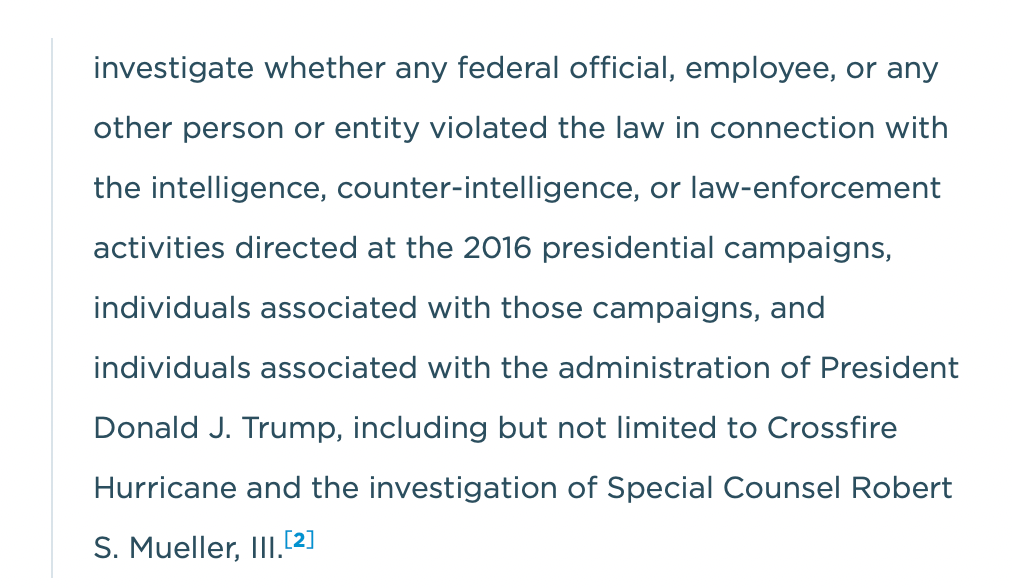
(Source: https://www.heritage.org/crime-and-justice/report/the-durham-investigation-primer)
November 3, 2020
2020 General Election is stolen
November 7, 2020
Joe Biden is declared the official winner of the 2020 election. Almost immediately Trump begins making unprecedented moves at the DoD; Trump appoints Acting Secretary of Defense, Christopher Miller as Secretary of Defense on November 9, 2020.
Miller has an extensive special operations and irregular warfare background. Here are a few of the many things he specialized in:
- Unconventional Warfare
- Counterinsurgency
- Foreign Internal Defense
***Foreign Internal Defense: Activities that are “designed to protect against subversion, lawlessness, insurgency, terrorism, and other threats to their internal security, and stability, and legitimacy.”***
Serving directly under Miller are two key figures from the early days of the Trump admin who helped uncover the Obama spy ring: Ezra Cohen-Watnick and Kash Patel.
“Ezra Cohen-Watnick [is appointed] the Pentagon’s new undersecretary for intelligence and security. Cohen-Watnick has reportedly favored using the U.S. intelligence community to undermine or oust Iran’s government. When he was at the National Security Council, he clashed with then-national security adviser H.R. McMaster and was forced out.”
“Kash Patel, [who served] at the White House on the National Security Council, [took] the chief of staff job. Patel worked as a staffer for Republican Rep. Devin Nunes and was reportedly involved in pushing the narrative that the Obama administration spied on the Trump campaign in 2016. In addition, he also made the case that the FBI and Justice Department acted improperly when investigating Trump.”
(Source: https://www.npr.org/2020/11/11/933868828/shake-up-at-pentagon-puts-trump-loyalists-into-senior-roles)
November 10, 2020: A Strategic Appointment – Brigadier General Anthony Tata
On November 10, 2020, shortly after the appointment of Christopher Miller as Acting Secretary of Defense, President Donald Trump takes another notable step by promoting Brigadier General Anthony Tata to the position of Senior Official Performing the Duties of the Undersecretary of Defense for Policy (USD(P)).
The role of Undersecretary of Defense for Policy is of paramount importance within the Department of Defense (DoD). It involves advising the Secretary of Defense on matters of national security and defense policy. One of the specific responsibilities associated with this role is the coordination of Department of Defense Directive 3020.26.
Department of Defense Directive 3020.26 is a critical policy directive that establishes the DoD’s continuity policy and assigns responsibilities for its implementation. This means that it sets out the procedures and plans for ensuring that critical Defense Department operations can continue unimpeded in case of a catastrophic event, such as a natural disaster, terrorist attack, or any other crisis that could disrupt the normal functioning of the government.
In summary, by appointing Brigadier General Anthony Tata to this position, one of the first priorities seems to be securing the continuity of government operations. The Undersecretary of Defense for Policy is responsible for developing DoD policy and providing oversight for Continuity of Operations and Continuity of Government, ensuring that the nation’s defense infrastructure remains functional and effective regardless of the circumstances.
This appointment reflects the importance placed on preparing and safeguarding the nation’s defense mechanisms during a period of transition and potential uncertainty.
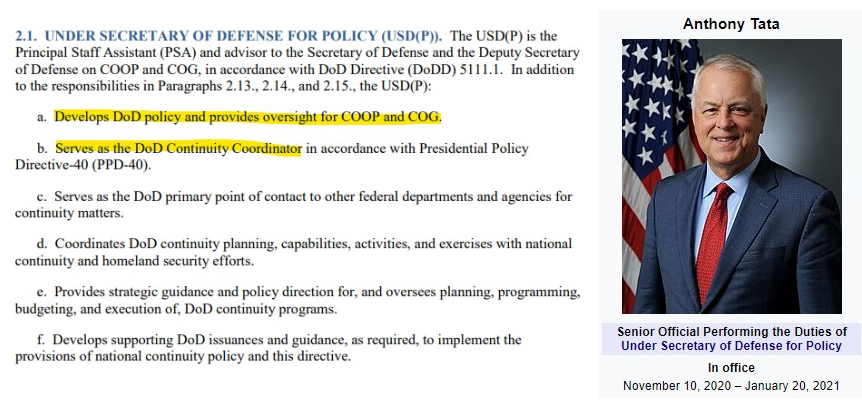
November 11, 2020: Ezra Cohen-Watnick’s Dual Role in Intelligence and Special Operations
On November 11, 2020, Ezra Cohen-Watnick, a figure who had already made his mark within the Trump administration, received a significant promotion. While continuing to serve as the Acting Assistant Secretary of Defense for Special Operations and Low-Intensity Conflict (ASD (SO/LIC)), Cohen-Watnick was also appointed to the role of Undersecretary of Defense for Intelligence (UDI).
With this promotion, Cohen-Watnick assumed a dual role, holding significant responsibilities within the Department of Defense. Not only was he serving as the Acting Assistant Secretary overseeing special operations, but he also became the top civilian official in charge of intelligence at the Pentagon. This dual role places him in a unique position, having oversight over both intelligence and special operations functions.
To understand the significance of Cohen-Watnick’s new position, it’s crucial to look back at his past roles. In 2017, Cohen-Watnick served as an advisor to the National Security Council, where he worked alongside General Michael Flynn. During his time in this role, he made a discovery that would have far-reaching implications.
Cohen-Watnick uncovered evidence of wire-tapping and the illegal unmasking of members of President-elect Trump’s campaign team, including General Flynn and Carter Page. This information was a critical component in what would later become known as the Nunes Memo. Cohen-Watnick shared his findings with Kash Patel, who was instrumental in drafting this memo in 2018, which called into question the actions of the Obama administration during the transition period.
Cohen-Watnick’s promotion to Undersecretary of Defense for Intelligence, coupled with his ongoing role as Acting Assistant Secretary of Defense for Special Operations and Low-Intensity Conflict, indicates a heightened focus on intelligence operations within the Department of Defense. His history of uncovering irregularities in intelligence practices and his dedication to transparency and accountability may be indicative of the direction the Department of Defense intended to take under his leadership.
November 18, 2020: Restructuring and Empowering Special Operations Within the Department of Defense
In a pivotal development this month, Acting Secretary of Defense Chris Miller made a significant change to the reporting structure within the Department of Defense. He directed the Assistant Secretary of Defense for Special Operations/Low-Intensity Conflict (ASD (SO/LIC)) to report directly to him.
The announcement of this change was made at Fort Bragg, North Carolina, a location that is deeply symbolic as it is home to the Special Forces Psychological Operations, also known as the “Ghost Army.” This unit has historically been involved in clandestine operations and psychological warfare, making Fort Bragg an iconic location for such an announcement.
By directing the ASD (SO/LIC) to report directly to him, Miller streamlined the communication process, ensuring that the Assistant Secretary could bypass bureaucratic red tape. This is a clear indication of the importance and urgency that the Department of Defense is attributing to special operations and low-intensity conflict.
Further solidifying the emphasis on special operations, Chris Miller signed a memorandum designating Ezra Cohen-Watnick as a “principal staff assistant.” In practical terms, this meant that Cohen-Watnick would also report directly to the Secretary of Defense and the Deputy Secretary of Defense.
But Cohen-Watnick’s roles didn’t stop there. He was also appointed by President Trump to chair the Public Interest Declassification Board in December 2020. This position holds the authority to recommend the declassification of certain documents, a role that could be critical in providing transparency and releasing previously classified information to the public in a timely manner.
With these changes, Ezra Cohen-Watnick emerges as a central figure in the Department of Defense, particularly in special operations and intelligence. The restructuring indicates an intention to enhance the agility and responsiveness of special operations within the Department of Defense.
(Source: https://policy.defense.gov/OUSDP-Offices/ASD-for-Special-Operations-Low-Intensity-Conflict/)
Remarks by Ezra Cohen-Watnick:
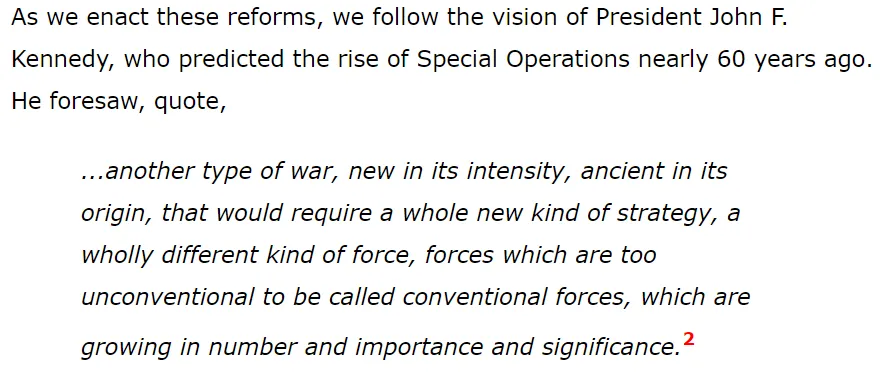

I also want to point out the location of where Miller and Watnick’s remarks were delivered. They do so next to the statue of “Bronze Bruce” in honor of the green berets. Bruce is standing on a stone that’s crushing the head of a serpent which symbolizes evil/corruption. Sound familiar?

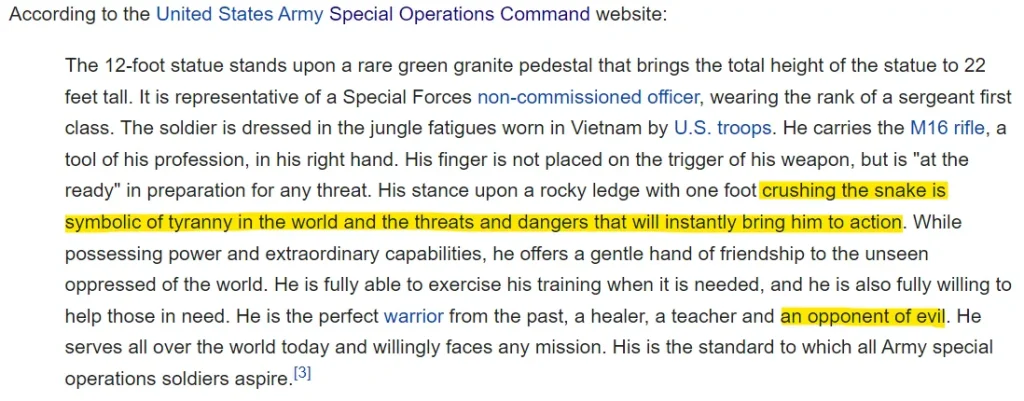
Does PSYOP fall under the Assistant Secretary of Defense for Special Operations and Low-Intensity Conflict (Ezra Cohen-Watnick)? It sure does!
December 7, 2020
Trump signed Executive Order 13961 (keep this EO in mind), also referred to as the “continuity of government” order. On the very same day, the Defense budget is increased to include Irregular Warfare. The budget increase would become law on January 1, 2021 (just before Biden “takes office”).

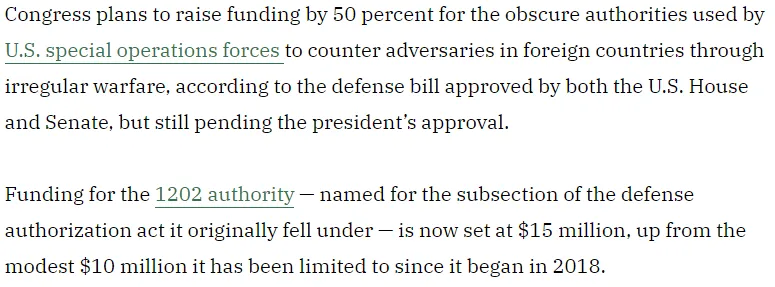
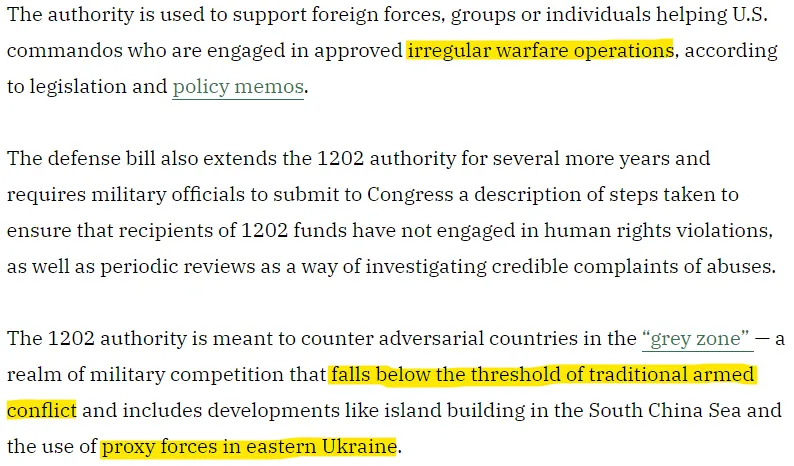
Think this was a coincidence? The same day Trump signs EO 13961 regarding Continuity of Government plan based on the context of irregular warfare the defense budget is expanded by 50% for this purpose.
Further evidence showing the “battlefield” was being prepped for irregular (and information) warfare came also from the 2020 National Defense Authorization Act (NDAA).
This article from “Lawfare Blog” explains it best:

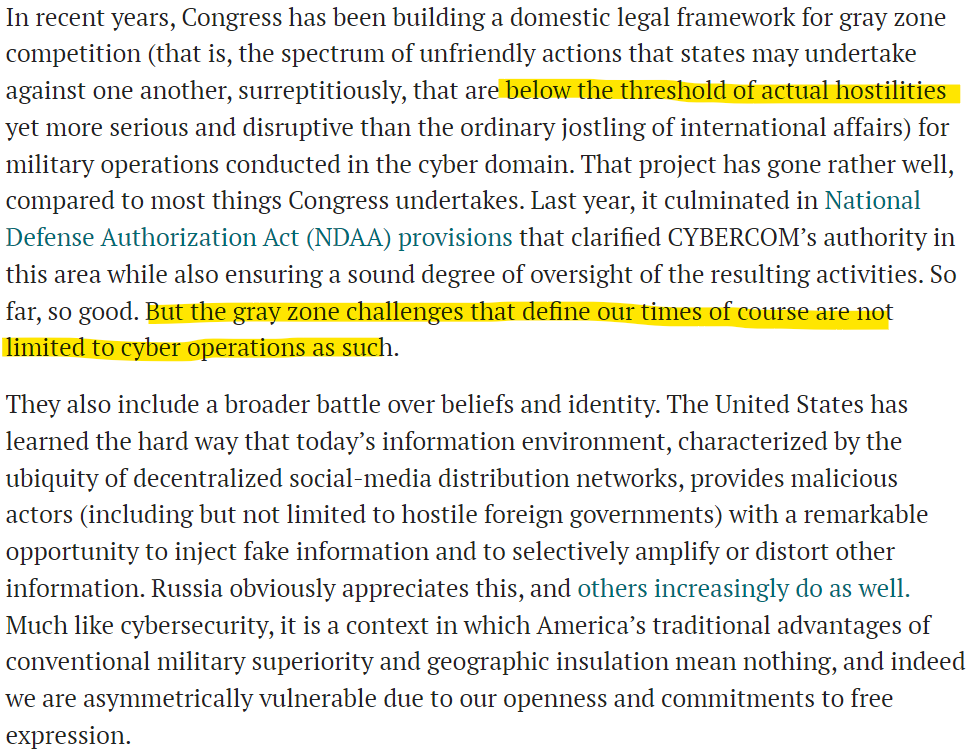
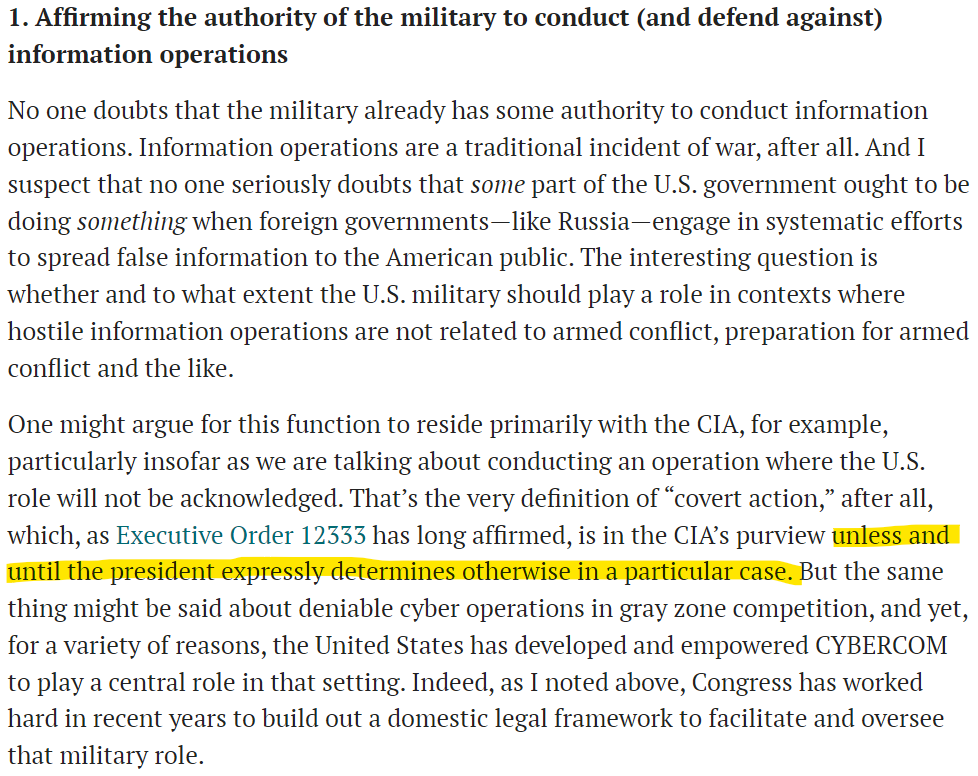
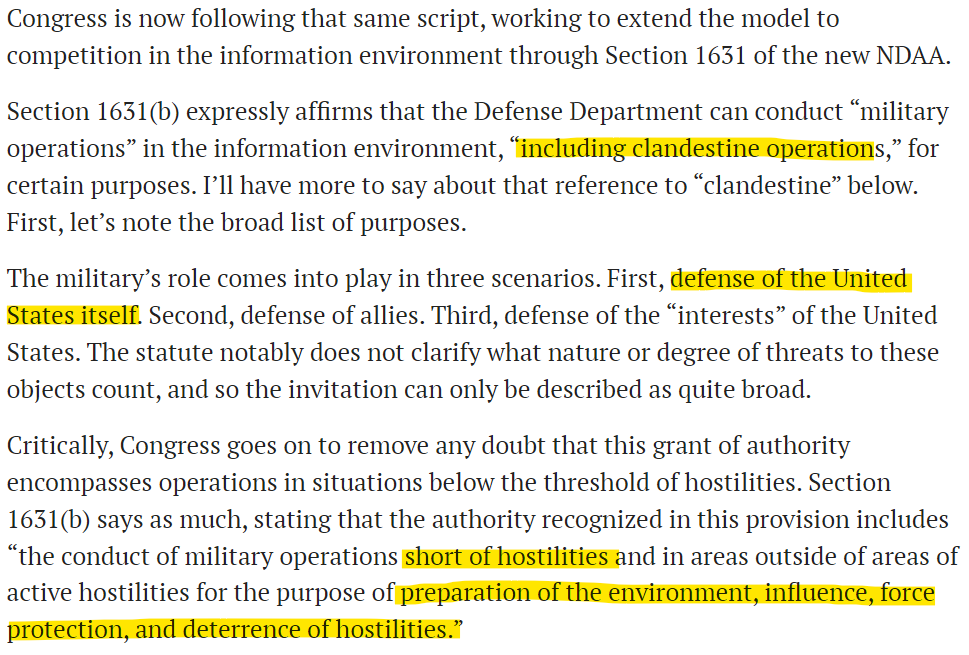
December 18, 2020
Press conference for 1st anniversary of Space Force, Chris Miller goes off script and makes peculiar remarks about VP Pence and having been involved in some of the most “complex military operations.” Having only served no more than 6 weeks as Acting Secretary of Defense, and with a transition of power on the horizon, what kind of complex operations are you conducting?
https://youtu.be/BuVgLpjf43o (16:00)
Is Miller referring to some kind of Irregular Warfare?
That same month a peculiar article by POLITICO is released reporting that the Trump Administration “refused to provide information about current operations, particularly in the special operations realm…”

As the individual in charge of the transition from Trump’s DoD, Kash Patel would have been playing a role in refusing to provide information to the Biden administration about current operations in the special operations realm.
What was the Trump team hiding?
It appears Trump and his team were setting up special operations, and it seems as if it was some sort of COG (continuity of government) plan.
So, in summary we have:
- One of the best special operations minds in our country was given command of the entire military as the Secretary of Defense (Chris Miller)
- The individual in charge of our nation’s special operations was made to report directly to the Secretary of Defense and was also placed in charge of our military’s intelligence (Ezra Cohen-Watnick)
- A Trump loyalist was placed in the role for the DoD that handles all COG planning and oversight (General Anthony Tata)
- The Trump administration and the DoD refused to provide information about what was taking place in the “special operations” realm (Kash Patel)
So let’s do one more recap and include a few of the additions:
- The 2020 NDAA from December 2019 gave wide-ranging authorities to the military to conduct “clandestine information operations”
- October 2, 2020 – The Irregular Warfare annex was added to the National Security Strategy and it came from the office of the Assistant Secretary of Defense for Special Operations/Low-Intensity Conflict (Run by Ezra Cohen-Watnick)
- November 3, 2020 – The Presidential election took place and was obviously rife with fraud
- November 7, 2020 – Joe Biden is declared the winner of the 2020 election
- November 9, 2020 – Christopher Miller, an Irregular Warfare guru, is named the Acting Secretary of Defense
- November 18, 2020 – Ezra Cohen-Watnick and Chris Miller give remarks at Fort Bragg during the ceremony which put “Special Operations Command on par with the military services for the first time.”
- December 7, 2020 – Executive Order 13961 and the accompanying “Strategy” are issued – based in the context of war and using very similar language to the IW annex.
- December 18, 2020: Chris Miller mentions “we’ve been through some of the most complex military operations this country has ever seen.”
- The 2021 National Defense Authorization Act (NDAA) included a 50% budget increase for 1202 Authority (Irregular Warfare)
- Trump’s DoD transition team “refused to provide information about current operations, specifically in the special operations realm” to the incoming Biden administration.
Question: What would be the purpose of all this if not to prepare for the implementation of some form of irregular warfare and continuity of government plan?
In an article published on October 14, 2020, David Ucko, professor and department chair at the College of International Security Affairs, publishes a fascinating article in which he discusses what’s known as the Irregular Warfare Annex document which it defines precisely the purpose of irregular warfare:


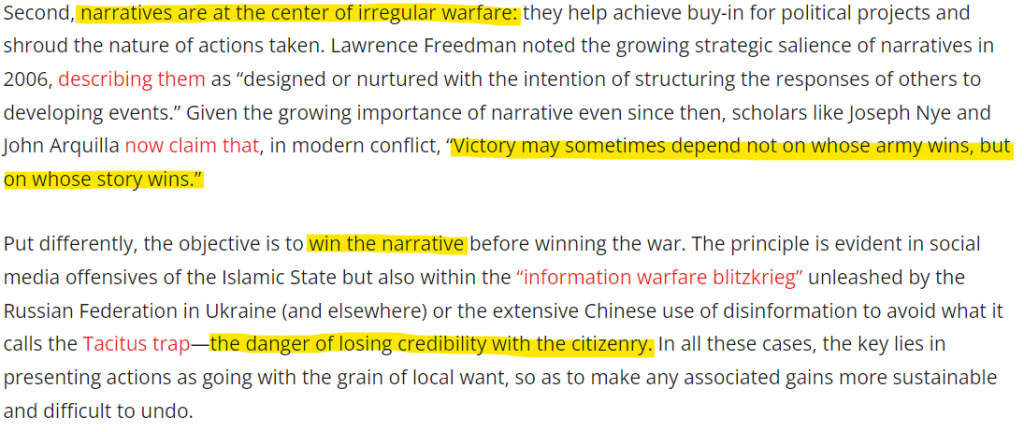
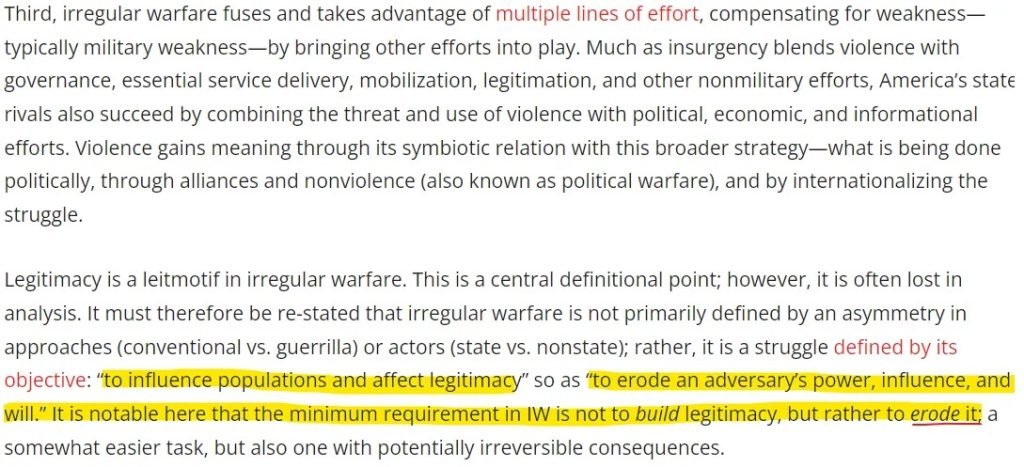
The Joint Chiefs of Staff / Understanding Chain of Command / COCOMs
A key to understanding all the above we have to also understand who and what is the Joint Chiefs of Staff, the Chain of Command, and Combatant Commands.
First, the Joint Chiefs of Staff consists of a chairman (CJCS), a vice chairman (VJCS), and the service chiefs of the Army, Marine Corps, Navy, Air Force, Space Force, and the chief of the National Guard Bureau. Each of the individual service chiefs, outside their JCS obligations, work directly under the secretaries of their respective military departments, e.g. the secretary of the Army, the secretary of the Navy, and the secretary of the Air Force.
Their primary role is to serve as advisors to the President of the United States (Source: The Joint Chiefs of Staff are nowhere within the Chain of Command)
As part of their advisory role, the Joint Chiefs of Staff create what is called the Joint Doctrine:

The Joint Chiefs outline the Joint Doctrine through a series of Joint Publications (JP). These publications offer a trove of information which provide us an in-depth look at how the military operates. The first thing to point out from these JPs is the function and priorities of the DoD and the Military.

It’s likely Trump started using the Military for active surveillance no later than June 1, 2020, in order to surveil the Antifa riots, which resulted in major pushback from Congress and the MSM. Just look at the blowback Trump receives from certain members of Congress:
- June 3rd, 2020 – Letter To Department Of Defense Regarding Insurrection Act
- Letter by (D) Vermont Senator Patrick Leahy
- Letter by (D) Vermont Senator Patrick Leahy
- June 9th, 2020 – Letter to FBI, NG, CBP, DEA on Government surveillance of protesters
- (D) Members of Congress pen a letter to FBI Director Christopher Wray expressing concern that the FBI and National Guard flew RC-26B aircraft equipped with infrared and electro- optical cameras over Washington, D.C. and Las Vegas
- the FBI may have flown Cessna 560 aircraft equipped with ‘dirtboxes,’ equipment that can collect cell phone location data, over Washington, D.C.
- the CBP flew Predator drones that collected and disseminated live video feeds over Minneapolis, San Antonio, and Detroit;
- the DEA was granted broad authority to “conduct covert surveillance” over protesters responding to the death of George Floyd.
- July 15th, 2020 – Congress must seize this chance to help demilitarize law enforcement
- Congress wants to ensure that local law enforcement isn’t militarized in any way per a decades old program called the “1033 program” which has made weapons of war available free of charge to law enforcement agencies across the country. Democract congressmen wanted to reform this act.
- Congress wants to ensure that local law enforcement isn’t militarized in any way per a decades old program called the “1033 program” which has made weapons of war available free of charge to law enforcement agencies across the country. Democract congressmen wanted to reform this act.
- August 7th, 2020 – Trump and Barr used a loophole to deploy the National Guard to U.S. cities. It’s time to close it.
- Dems express concern that Trump is using military and federal law enforcement like his own personal security force.
However, while Trump said he would enact the Insurrection Act, he never did. Why? He didn’t have to.
The loophole he chose to circumvent the hype the Left in Washington and the MSM were pushing was the Posse Comitatus Act (PCA), which states:
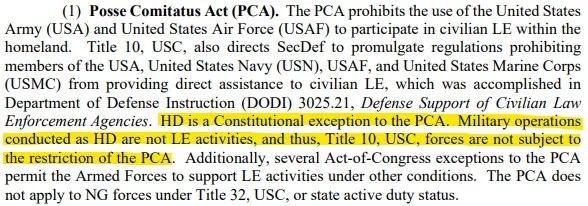
***Remember when Trump said he was a “wartime” president? He was very much taking a war-like posture against the Left, DNC, Deep State, etc. and enacted the process of devolution through the military***
Understanding Chain of Command
Everything starts at the top with our President; the Commander-in-Chief of our armed forces. From there, the Chain of Command goes to the Secretary of Defense and then to the Combatant Commanders (COCOM).
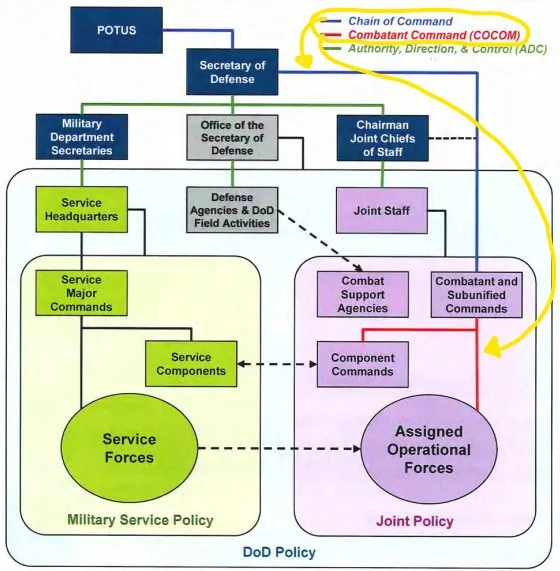
Combatant Commanders (COCOM) are the highest echelon of military commanders and they are overseen by what’s called the Unified Command Plan (UCP). There are 11 COCOMs in total:
- U.S. Northern Command
- U.S. European Command
- U.S. Central Command
- U.S. Africa Command
- U.S. Inso-Pacific Command
- U.S. Southern Command
- U.S. Space Command
- U.S. Special Operations Command
- U.S. Transportation Command
- U.S. Strategic Command
- U.S. Cyber Command
- 7 COCOMs are responsible for a specific geographical region of the world.
- 4 COCOMs are designated as “functional” – meaning they are responsible for a specific type of operation.
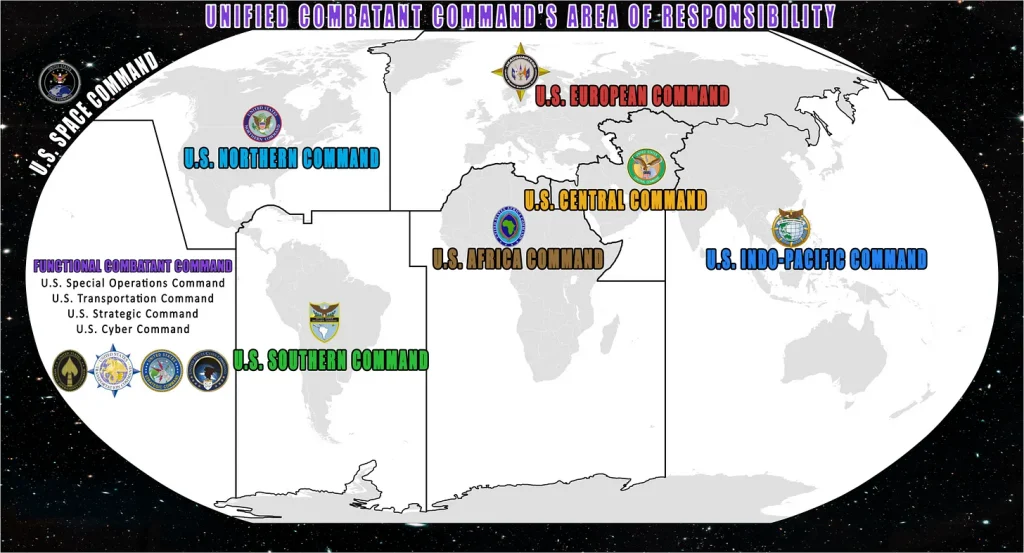
Of the 11 Combatant Commanders, 10 were installed during the Trump presidency. The 11th, Admiral John C. Aquilino (U.S. Indo-Pacific Command), was installed under Biden. What’s interesting about Aquilino is that he was responsible for the promotion of Charles A. Flynn to U.S. Army Pacific Command. He is the brother of one General Michael Flynn, former national security advisor to Trump during his 2016 campaign.
- Think of it in terms of running a business. Chris Miller would be the CEO and the Combatant Commanders would be the heads of their respective departments. If the business needs to implement major changes, the CEO wouldn’t broadcast their plans immediately to every employee from every department, would they? Instead, the CEO would privately inform the heads of each department. Once everything was in place for the smoothest transition possible, the heads of each department would disseminate information as needed to those within their departments required to implement the change. In our scenario, the “major change” would be the reveal that Trump implemented Devolution because the election was stolen via foreign interference.
- Think about that for a moment. Nobody outside of the Combatant Commanders would need to know this information.
- “…each COCOM commander answers directly to the Secretary of Defense.” (Source: https://nationalinterest.org/blog/reboot/what-combatant-command-176257)
- This may likely be what SOD Chris Miller was alluding to in his off-script comments during the press conference with VP Pence for the first anniversary of Space Force: “We’ve been through some stuff! We’ve gone through some of the most complex military operations this country has ever conducted…” (Source: https://youtu.be/jzDUVFRXGsA)

- The above paragraph is essential to understanding how Devolution would be possible even though Biden assumed office as an illegitimately elected “president” and filled out his staff in the Pentagon and the DoD with his own people.
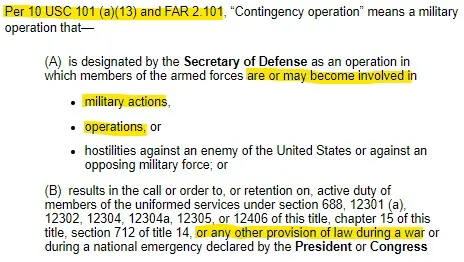
- If Secretary of Defense Chris Miller was provided proof that a foreign adversary not only interfered with our election, but to such an extent that the outcome of that election had been altered, he would have been obligated to share that proof with each of the COCOM Commanders. They would have recognized that the incoming Biden “administration” was not legitimate, and the contingency plan, Devolution, would have been implemented.
The Combatant Commanders (COCOM) would play an integral role in Devolution/COG. These are the commanders of our armed forces — the very people Secretary of Defense Chris Miller would have briefed if plans of Devolution were to be implemented. It’s likely the Devolution/COG plan may have been carried out by Ezra Cohen Watnick and the Special Operation Forces which have been tasked with carrying out the Mission Essential Functions (MEFs).
Evidence of Continuity of Government (Devolution) plan surfaces as early as 2018
May 8, 2018
The military took the key initiative in defending our United States elections by elevating U.S. Cybercom to Combatant Command.
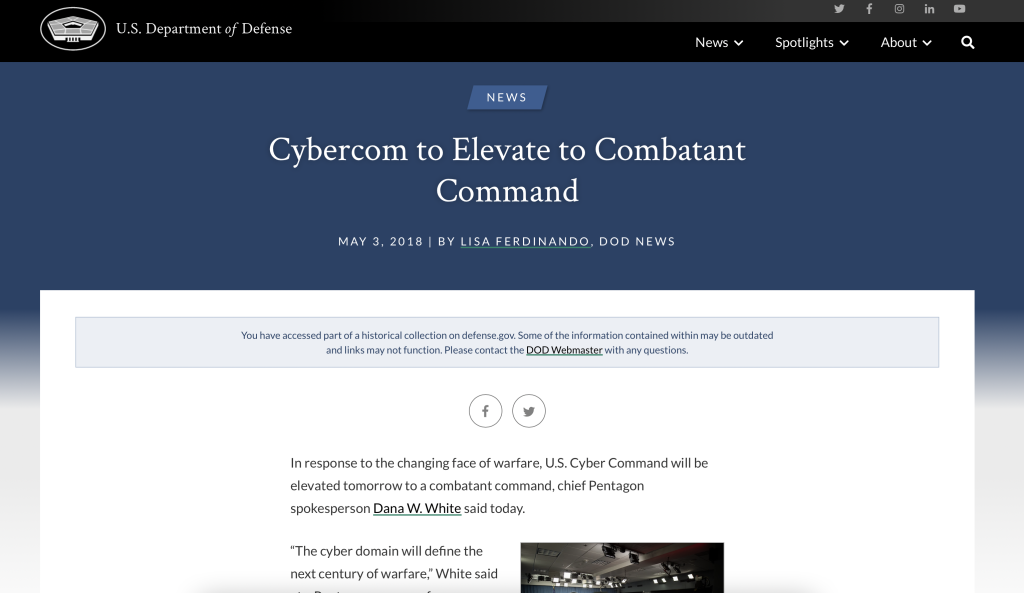
The elevation of Cyber Command to a COCOM allows Cyber Command to report directly to the Secretary of Defense. Cyber Command’s COCOM commander is General Paul Nakasone who is also the head of the NSA.
June 18, 2018
President Trump directs the DoD to “immediately begin the process to establish Space Force as the 6th branch of the armed forces.” I point this out because it’s likely the Space Force played a complimentary role, not a central role in the surveillance of the 2020 election.
July 23, 2018
General Paul Nakasone (the head of the National Security Agency and U.S. Cyber Command) confirmed that he has set up a task force to counter Russian cyberthreats to the United States.
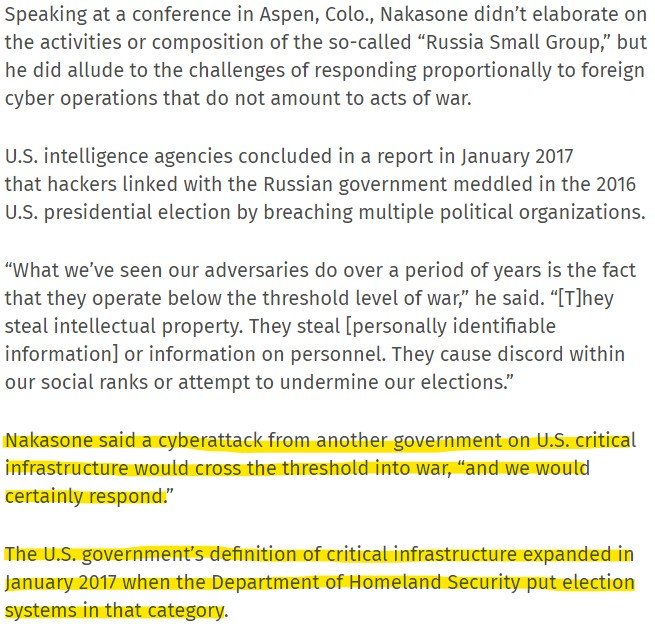
Remember January 6, 2017? When Obama Homeland Defense Secretary, Jeh Johnson made our election system part of critical infrastructure. It’s all coming back to bite them.
General Nakasone tells us in July of 2018 that they anticipate our adversaries will “try to penetrate such things as our critical infrastructure.” They were very clearly preparing for any foreign interference in our elections.
August 16, 2018
The Wall Street Journal published an article titled “Trump, Seeking to Relax Rules on U.S. Cyberattacks, Reverses Obama Directive”. The article is behind a paywall but I’ll post screenshots of some of the highlights.
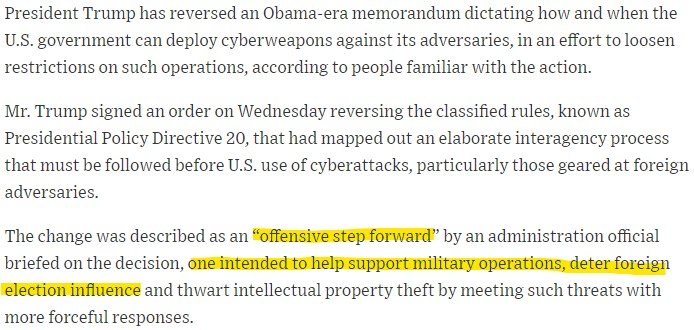

By removing some of the obstacles in PPD-20, Trump allowed the military to respond directly to election interference without having to cut through “red tape.” Not only did he elevate CyberCom to a COCOM to protect election infrastructure and eliminate the “middle men” in the military’s chain of command itself, but in PPD-20, he also untied their hands by eliminating the unnecessary layers of federal agencies required to approve any plan of action.
All this before the 2018 midterm elections…hmmm
September 7, 2019
The NSA prepares to defend our elections after what they learned in 2018.
December 20, 2019
US Space Force is born
February 10, 2020
DoD publishes an article stating Space Force will have enduring role in election defense.
(Source: DOD Has Enduring Role in Election Defense > U.S. Department of Defense > Defense Department News)
May 2, 2022
Video is released by the 4th PSYOP Group under the 1st Special Forces Command: https://youtu.be/VA4e0NqyYMw
August 8, 2020
Months before 2020 election, DoD states threat to 2020 election is much bigger than Russia.
November 3, 2020
General Election
December 9, 2020
Director of National Intelligence John Ratcliffe announces Space Force will become the 18th member of the U.S. Intelligence community.
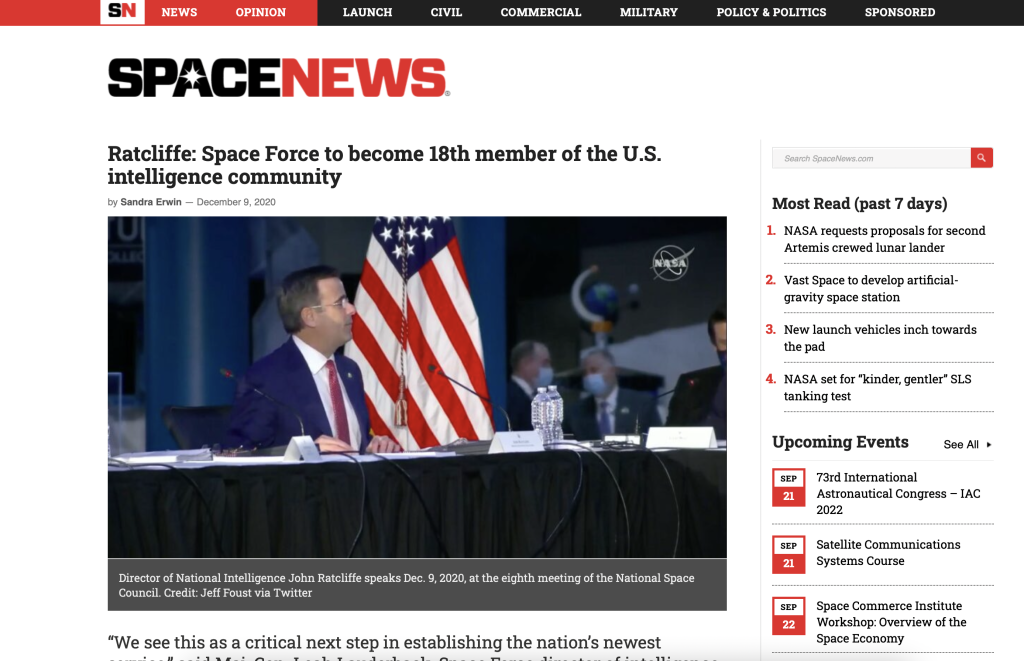
Recall, December 9 is just 10 days before that press conference on the first anniversary of Space Force when Chris Miller went off script and made those cryptic remarks to VP Pence.
Space Force likely played a complementary role to what Cybercom and the NSA were doing under General Nakasone.
“There is no strategic-level cyber capability without space”. Creating Space Force was necessary to give Cybercom and the NSA the maximum capabilities required to defend our election infrastructure. As usual, Trump and our military were forward-thinking as early as 2018 when they started the process to create Space Force.
What is the 4th PSYOP Group / 1st Special Forces Command?

May 2, 2022
Video is released by the 4th PSYOP Group under the 1st Special Forces Command: https://youtu.be/VA4e0NqyYMw
The 4th PSYOP group conducts influence activities and plays a key role in information warfare.
(5 years ago) —> On Nov. 6, 2017, an article from the Army Times states the “psychological operations community is getting its name back.” This happened during Trump’s first year in office. (Source: https://www.armytimes.com/news/your-army/2017/11/06/the-armys-psychological-operations-community-is-getting-its-name-back/)
Before going back to being named the 4th PSYOP Group, they were referred to as the Military Information Support Operations (MISO) Group.

MISO is considered part of Irregular Warfare (IW) and remember, the 4th PSYOP Group are “masters of influence.” The above screenshot is very important because of what it’s from and when it was released. (See Annex cover below).
October 2, 2020
DoD releases a declassified summary of the Irregular Warfare Annex to the National Defense Strategy (Link: https://media.defense.gov/2020/Oct/02/2002510472/-1/-1/0/Irregular-Warfare-Annex-to-the-National-Defense-Strategy-Summary.PDF)
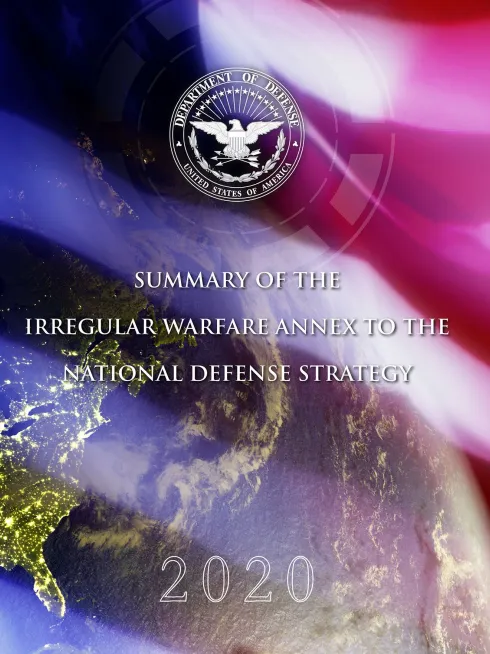
Notice the date of its release? Nearly one month before the November 3rd election, an annex was added to the National Defense Strategy specifically for Irregular Warfare (IW) – something that would heavily involve the 4th PSYOP Group / Special Forces Command.
The Military’s definition of Irregular Warfare comes from the Joint Publication 1: Doctrine for the Armed Forces of the United States (more on what a Joint Publication is later, which will make more sense) dated July 12, 2017. (Source: Joint Publication 1: Doctrine for the Armed Forces of the United States:)
One of the main functions of Irregular Warfare it states is information.

The change to the Armed Forces Doctrine dated July 12th, 2017, was an addition of the “information function” which has to do with influencing perceptions and leveraging information during all military operations. It’s as if this change was tailor-made for the 4th PSYOP Group.
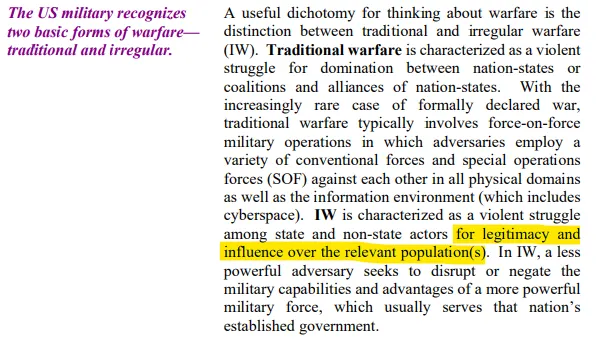
This is precisely how the 4th PSYOP Group describes itself:

So without question, you see information warfare is a key component of Irregular Warfare and the 4th PSYOP Group would be heavily involved in any form.
It’s important to note who released the declassified Annex on Irregular Warfare.
Let’s take a look…
On October 19, 2020, Secretary of Defense Chris Miller co-authors an article entitled:

In the article, Miller basically makes a case for why our Special Forces need to be configured for Irregular Warfare. And here is where he mentions the Irregular Warfare Annex document from above:
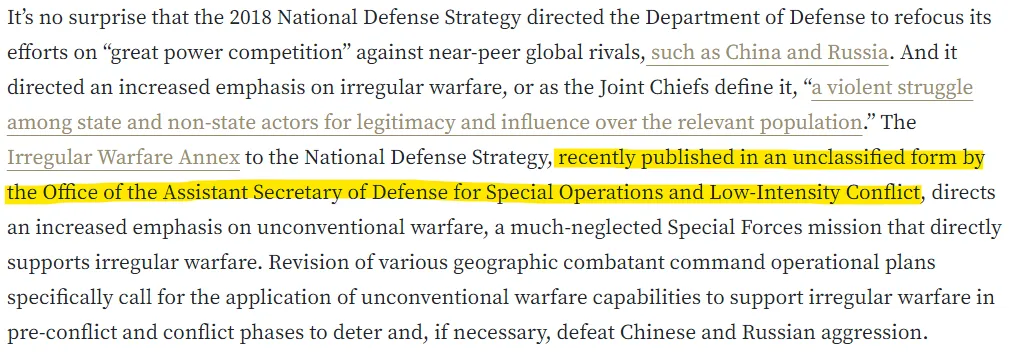
He mentions the Office of the Assistant Secretary of Defense for Special Operations and Low-Intensity Conflict.
Recall who was appointed to that role under Secretary of Defense Chris Miller.
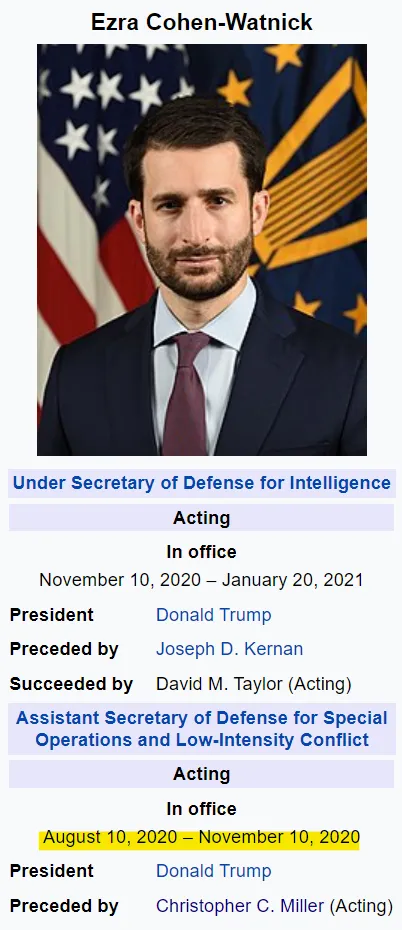
Literally, 17 days after Ezra Cohen-Watnick’s office releases the Irregular Warefare Annex document, Miller is penning this article on upgrading our Special Forces to handle Irregular Warfare.
Still think it’s a coincidence?
So, basically, what the IW Annex does is it places all forms of Irregular Warfare under the scope of Special Operations.
Then only two months later….
December 7, 2020
Trump signs Executive Order 13961 on Governance and Integration of Federal Mission Resilience or what we can refer to as the COG EO (Continuity of Government Executive Order).
This EO was released simultaneously with the Federal Mission Resilience Strategy 2020 (FMR).
(Source: https://www.govinfo.gov/content/pkg/FR-2020-12-10/pdf/2020-27353.pdf)
Between Trump’s EO and this Strategy, you’ll find the entire framework for COG/devolution.
What is the Federal Mission Resilience Strategy?
PDF: https://www.hsdl.org/?view&did=848323
In the introduction letter by Trump in the FMR document he states:
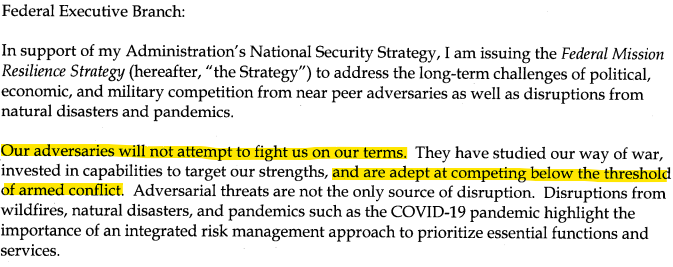
That language sounds awfully familiar. Let’s go back to the IW Annex document:


It’s important that we see Trump’s EO and the release of the FMR Strategy only two months prior in the same light.
Let’s look at the text from the EO itself where it discussed the FMR Strategy:
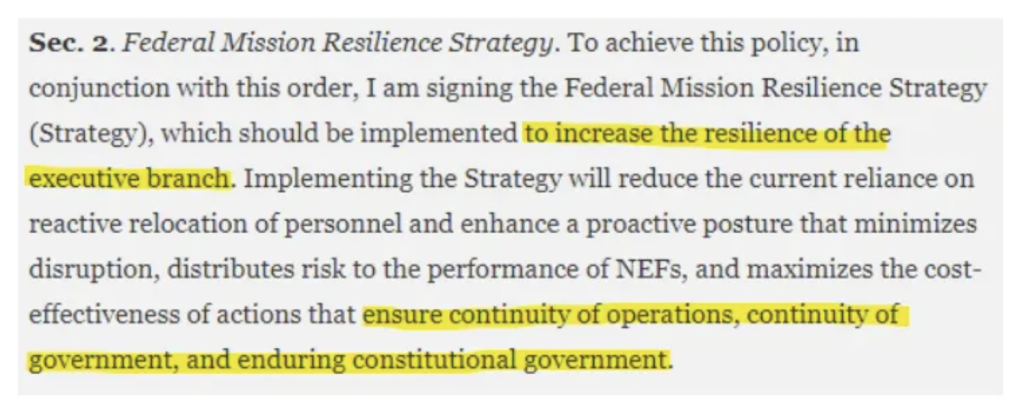
Between these two documents, we see that Trump is indicating a clear goal of moving from a “reactive posture” to a more proactive posture when it comes to the continuity of government.
In order to make this type of shift, Trump had to have had knowledge of what was coming to cause such a potential disruption.
What was the context for and by what authority did Trump sign Executive Order 13961?
This executive order begins by telling us under what authority Trump has issued it. In addition to the Constitution and laws of the United States, the National Security Act of 1947 is mentioned specifically. The National Security Act of 1947 is found in Chapter 44 of United States Code, Title 50 – War and National Defense.
In the first paragraph of the Executive Order Trump explains:
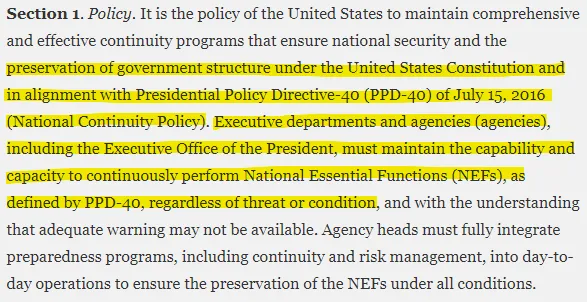
The Presidential Policy Directive-40 (PPD-40) is still a classified document, which was signed by Obama. A list of the National Essential Functions (NEF) mentioned, however, can be found in a document put out by FEMA through Federal Continuity Directive 1 & Federal Continuity Directive 2. Both are based on what is in PPD-40.
Federal Continuity Directive 1 has a section dedicated to “Devolution” specifically. There are 8 National Essential Functions (NEFs) which are listed in the FEMA document:

In summary, the whole purpose of the Executive Order and the Federal Mission Resilience Strategy is to “increase the resilience of the executive branch” and to “ensure the continuity of operations, continuity of government, and enduring constitutional government.”
Why would any outgoing president need to implement a COG plan if indeed Biden were legitimately elected?
Keep this in mind (and recall): TRUMP IS A WARTIME PRESIDENT
Federal Mission Resilience Executive Committee
An even more interesting detail about the FMR Strategy is that as part of the implementation of the Strategy, it requires a committee to do so. Section 3 of the Executive Order establishes the Executive Committee which is comprised of:
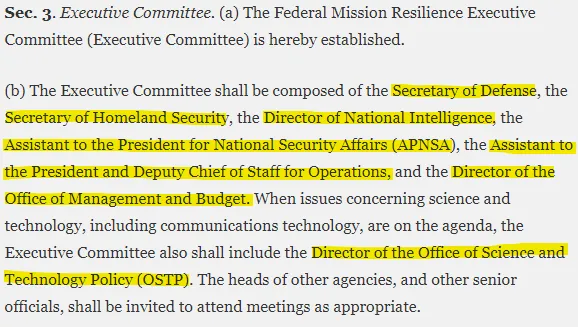
These individuals are essentially the brains behind the COG/devolution process:
Secretary of Defense: Christopher Miller
Secretary of Homeland Security: Chad Wolf
Director of National Intelligence: John Ratcliffe
Assistant to the President for National Security Affairs (APNSA) – Also known as National Security Advisor: Robert O’Brien
Assistant to the President and Deputy Chief of Staff for Operations: Tony Ornato
Director of the Office of Management and Budget: Russell Vought
Director of the Office of Science and Technology Policy: Kevin Droegemeir – Kevin would only attend when issues concerning science and technology, including communications technology are on the agenda.
Their responsibility is to (just read the highlights):
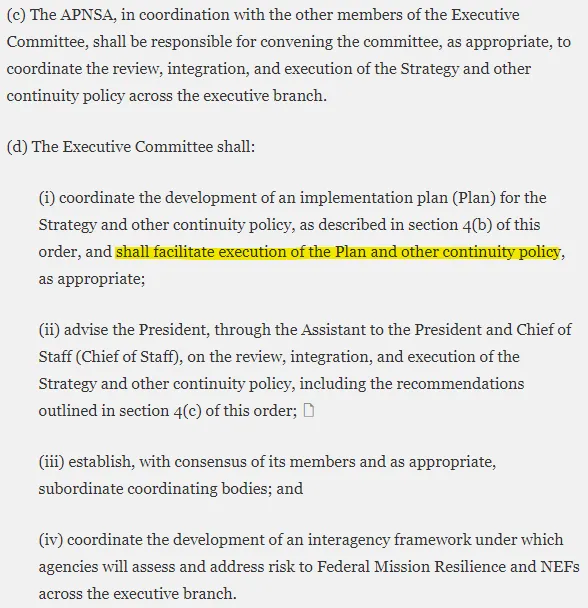
How is the FMR Strategy to be Implemented?
Section 4 of the EO reads as follows:

Who was Trump’s Chief of Staff at the time? Mark Meadows
While Meadows is not on the Executive Committee for the FMR, he plays a key role in facilitating and implementing the EO and the FMR Strategy.
Meadows was the only Cabinet member to see President Trump off on January 20, 2021, when he left office from Joint Base Andrews, and is the only member of his cabinet Trump publicly acknowledges.
Like any good plan, it requires a proper chain of communication.
During his address, Trump says, “We will be back in some form.”
That’s an interesting statement to make. Why not simply say, “We’ll see you again in 2024”? Or “We’ll be back in 2024”?
Further proof that Continuity of Government/Devolution is in play
On July 7, 2022, Julie Kelly – a “self-appointed fact checker of the Left” – posts a screenshot on Twitter of an amendment to the National Defense Authorization Act (NDAA) put forth by Congressman Adam Schiff:
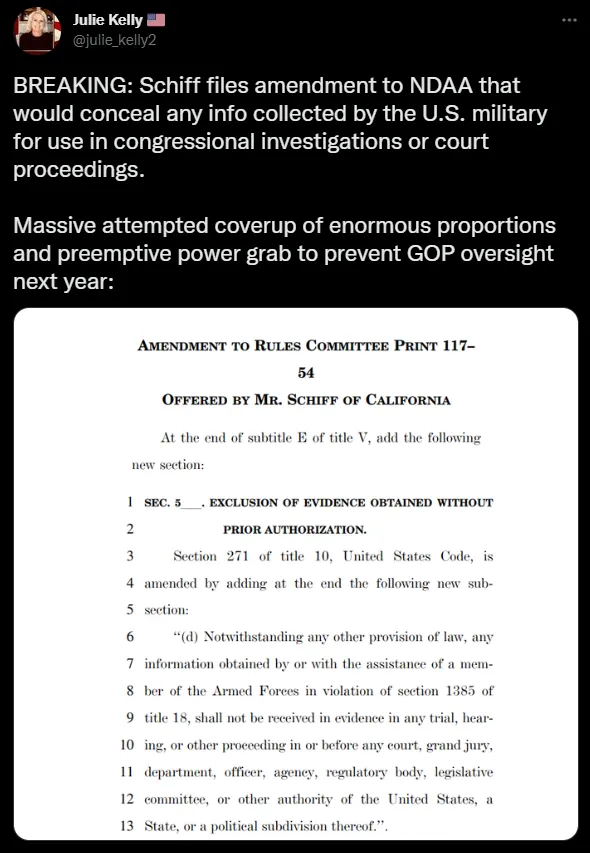
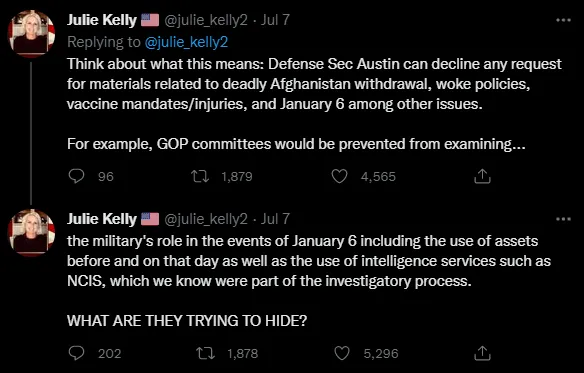
Her assessment is mostly accurate, minus one “minor” detail. We need to look at what exactly Schiff’s amendment would be amending:
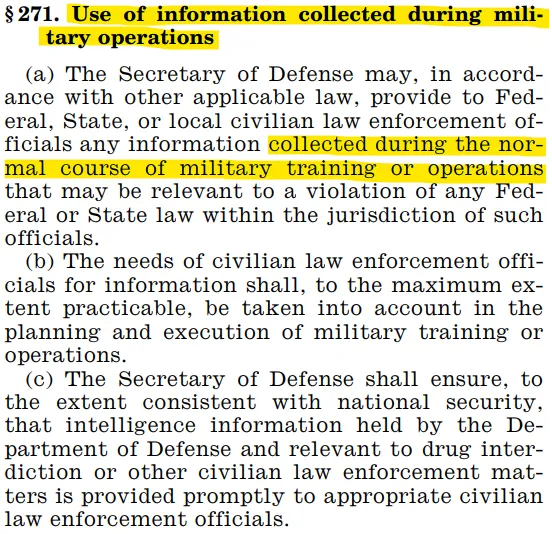
Here is what Schiff’s amendment adds to the end of the above section:
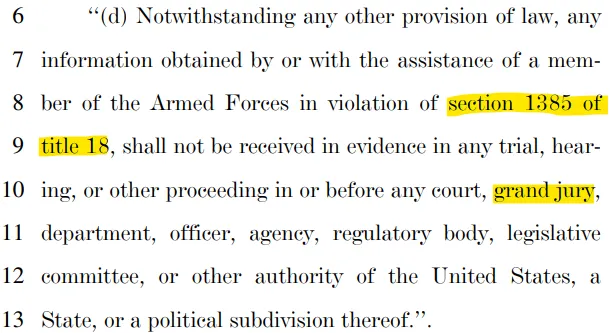
The addition states that information obtained by or with the assistance of the military cannot be used as evidence in basically any fashion (the key here being grand juries) if it violates section 1385 of Title 18.
What does section 1385 of Title 18 say?
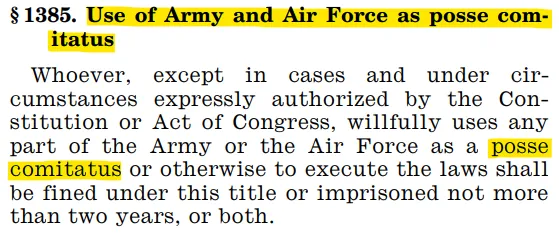
What does the Posse Comitatus Act say?
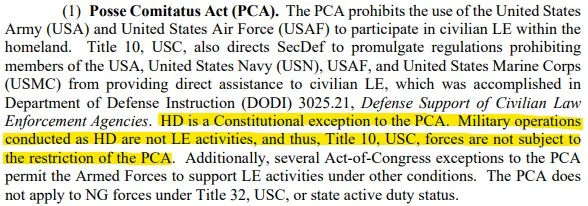
Essentially this means that “unless authorized by the constitution or Act of Congress,” the military is not allowed to participate with civilian law enforcement in any fashion here within the United States.
Adam Schiff’s amendment is saying that any information that comes from our military in violation of the Posse Comitatus Act cannot be used as evidence in basically any proceeding, and that includes Grand Juries.
Why put forth this amendment?
Think about it logically. How do the Democrats and Schiff operate? The policies and agendas they put forth like this are typically in reaction to something. There is a school shooting so they put forth a gun control bill. They get caught stealing an election through the use of geo-tracking, so they take action to crack down on people selling geo-tracking data.
Think cause and effect.
The “effect” in this situation is Adam Schiff’s amendment trying to prohibit the use of information gathered through “violations” of domestic military operations as evidence in any form of proceedings.
The “cause” can only be that there is some form of domestic military operation gathering intelligence in the first place.
So using our deductive reasoning we can conclude that there is some domestic military operation taking place.
Go back to what Title 1385 says:
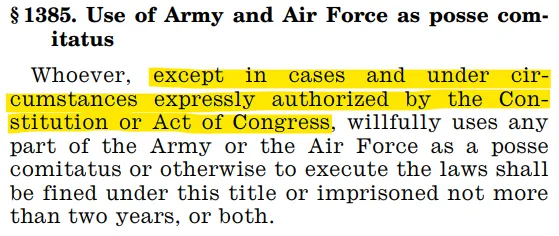
1.) Acts of Congress; OR
2.) Circumstances expressly authorized by the Constitution
Since Adam Schiff is a congressman and he is also the one who put forth this amendment, it’s safe to conclude that if there are any military operations happening domestically, it would be one that was not authorized by Congress. If it was something he authorized, why would he be worried and put this forth at all?
So what are the other “circumstances” that could initiate domestic use of the military?
Homeland Defense would certainly qualify as a “Constitutional exception.”
If the military was going to operate domestically, somebody would have to give the order for them to do so, and an order like this would have to come from the very top. So let’s look at the chain of command:
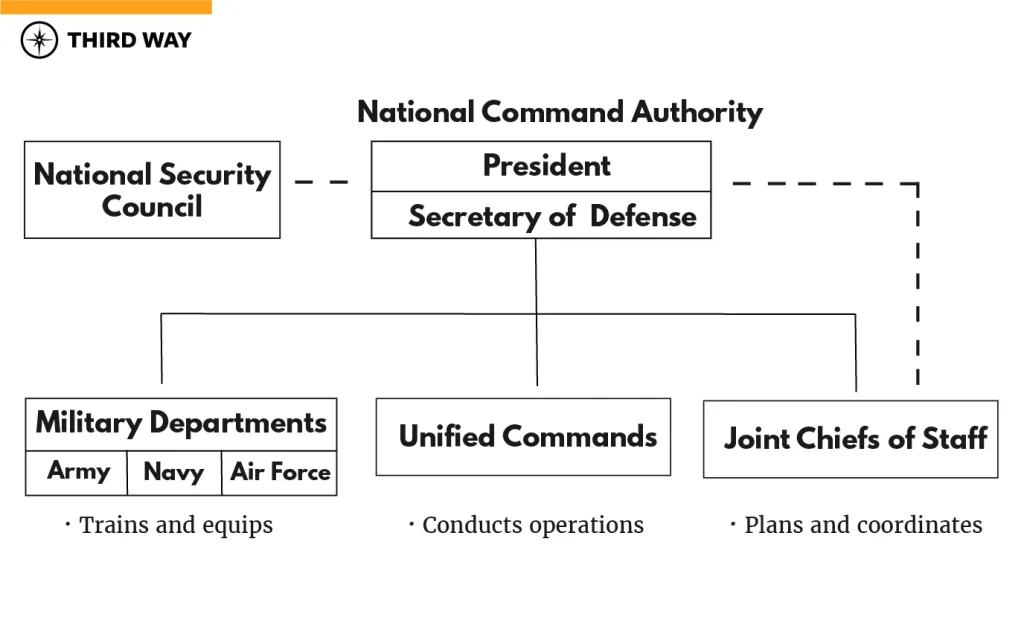
If it wasn’t Congress that authorized the military to operate domestically, it had to have been the President, but the current President, Joe Biden, is an ally of Adam Schiff. Why would Adam Schiff put forth a bill that could somehow affect something Joe Biden authorized? It doesn’t make any sense?
This obviously leads me to the entire basis of my theory. Donald Trump knew the election was going to be stolen, he considered it an act of war, and he implemented a continuity of government plan as his countermove based on the context of irregular warfare.
Recap:
- Adam Schiff’s amendment tells us there is some form of domestic military operation happening
- Because Schiff brought it forth, the operation must not have been authorized by Congress
- Because Joe Biden is an ally of Schiff’s, it must not have been authorized by Joe either
- This leaves us with an ongoing domestic military operation, that Adam Schiff is afraid of, which must have been initiated by none other than President Trump
So if this goes through, and it is revealed that there in fact is some form of ongoing domestic operation, who determines whether or not it was happening in violation of the Posse Comitatus Act? That would be the Supreme Court, and luckily we already have precedence and Trump had every authority to implement Devolution:
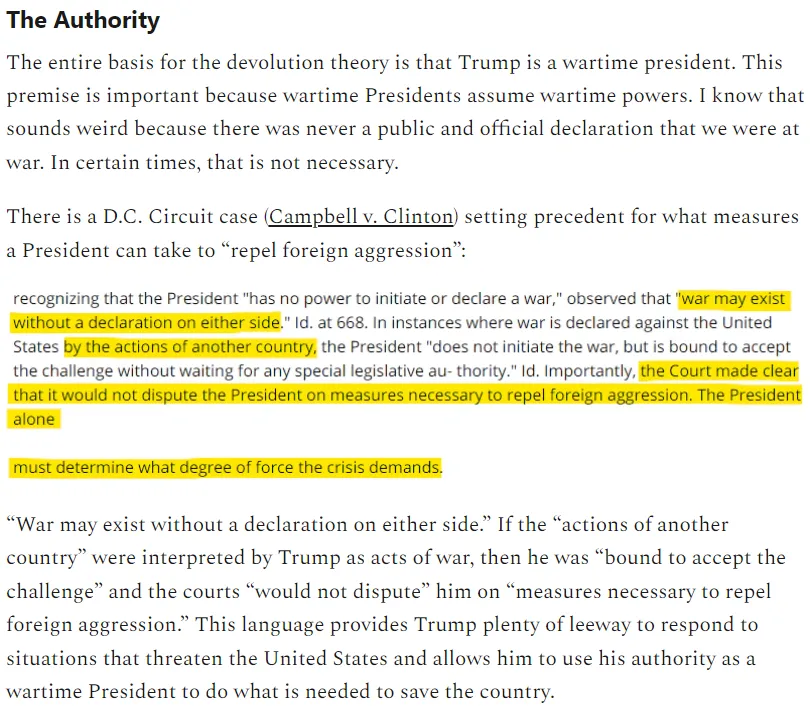
Schiff’s amendment provides us all the more circumstantial evidence that something is happening behind the scenes that have the DC Swamp and their accomplices in a panic.
Biden’s DoD wants an audit of all the clandestine operations currently underway
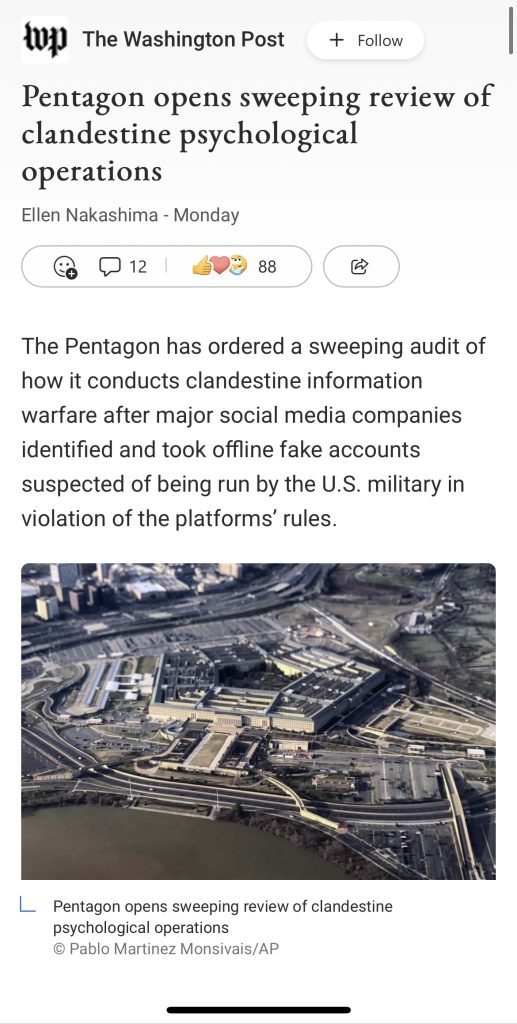
Why do you think Biden would call for such an audit?
I think we’re about to find out in due time.
